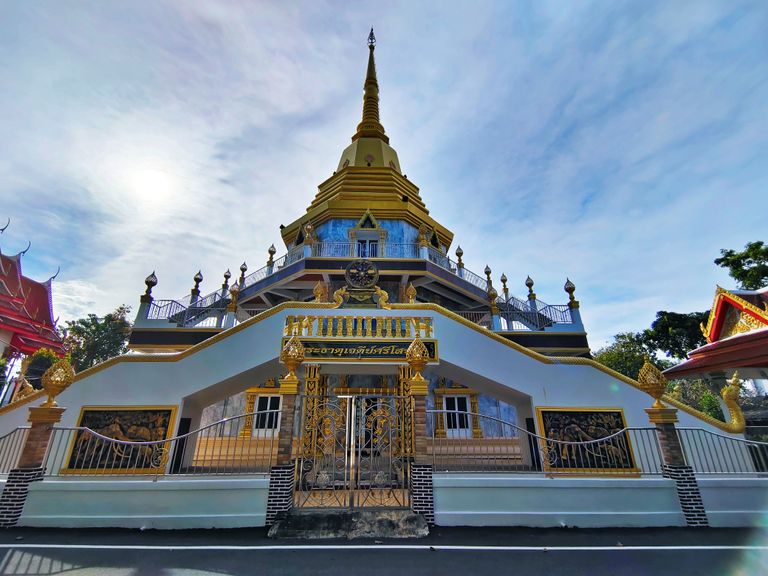
Hello everyone
Are you planning a trip to Phuket? Do you enjoy exploring Thai Buddhist temples, or perhaps you love wandering through lively flea markets filled with street food and unique finds? If so, I’ve got the perfect spot for you that combines both experiences! Nestled in Phuket Town, specifically in the Wichit Subdistrict, Mueang District, this place promises a great Saturday or Sunday afternoon adventure. 😊
Phuket Town is home to two well-known weekend markets. Today, I’m taking you to a special gem located just opposite the vibrant Phuket Naka Weekend Market (formerly known as Chaofa Variety Market). This market is a favorite for locals and tourists alike, opening at 4 PM, giving you the perfect opportunity to visit the temple before diving into the market's buzz. 🛍️🍜
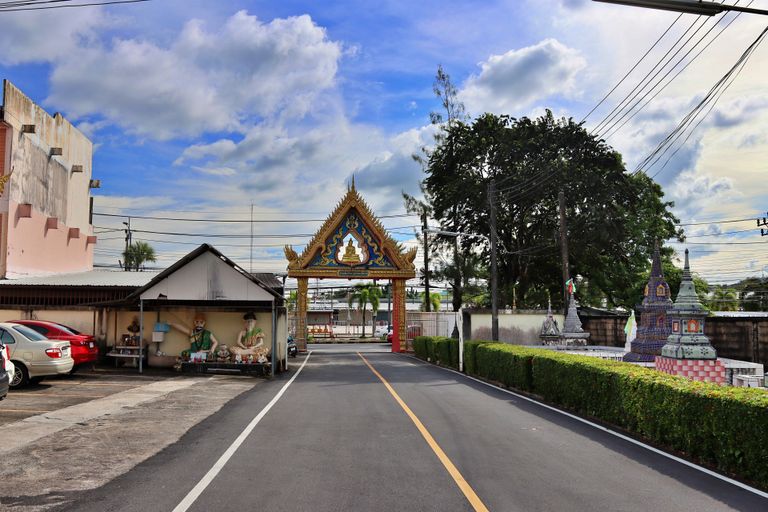
In the photo above, you can see the parking area of the Naka Market across the street. To the right, you’ll notice the traditional Thai burial graves, offering a glimpse into local customs.
The temple in focus is Wat Nakaram (วัดนาคาราม) — “wat” meaning temple in Thai. Wat Nakaram boasts a fascinating history tied to the island’s past, and it holds a special place in the community.
Phuket’s rich heritage is deeply connected to its tin mining industry, which was once a dominant economic force. The land where Wat Nakaram now stands was previously part of a dune used by the Anuphat Phuket Mining Company. It was generously donated by Mr. Wirat Hongyok, a member of one of Phuket’s most influential families, about 50 years ago.
The first structure on the site was a modest pavilion built in 1964, making it one of the oldest temples on the island. Today, Wat Nakaram is a cherished site of worship, offering a peaceful retreat and a window into Phuket’s cultural heritage.
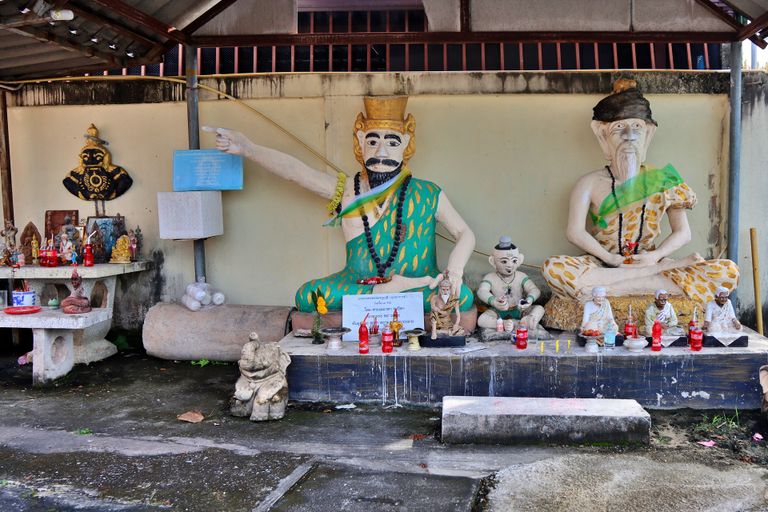
สวัสดีคร้าาาาาาาาา..... ถ้าคุณมีแพลนจะมาเที่ยวภูเก็ตช่วงวันหยุด ใครสายบุญ ชอบเข้าวัดทำบุญ แล้วก็ยังชอบช้อปปิ้งด้วย บัวขอแนะนำนี่เลยค่ะ วัดนาคา หรือวัดนาคาราม เป็นวัดที่อยู่ตรงข้ามกับตลาดนัดนาคา หรือตลาดนัดเจ้าฟ้าวาไรตี้ ไปทำบุญที่วัดแล้ว หลังจากนั้นก็ข้ามถนนไปช้อปกันต่อเล้ยยยยยย..... ตลาดนัดนาคาเป็นตลาดนัดที่ใหญ่ และมีสินค้ามากมาย หลากหลายเลยแหล่ะ
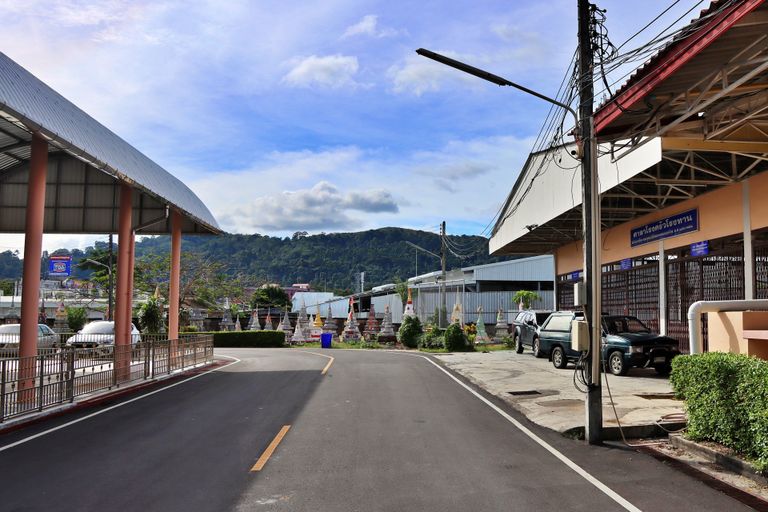
From this vantage point, you can see the Phuket hills rising behind the traditional Thai burial stupas, known in Thai as ธาตุเก็บอัฐิ (Thaat Kep Ati), which serve as reliquaries for the ashes of deceased family members. In Thai Buddhist tradition, after cremation, the ashes are often interred in these miniature stupas or chedis, which are placed near the perimeter of the temple grounds.
In Buddhist culture, these burial stupas are meant to honor the memory of the deceased, offering a place where family members can come to pay their respects. They are usually located close to the temple fence, symbolizing a spiritual boundary between the world of the living and the realm of the departed.
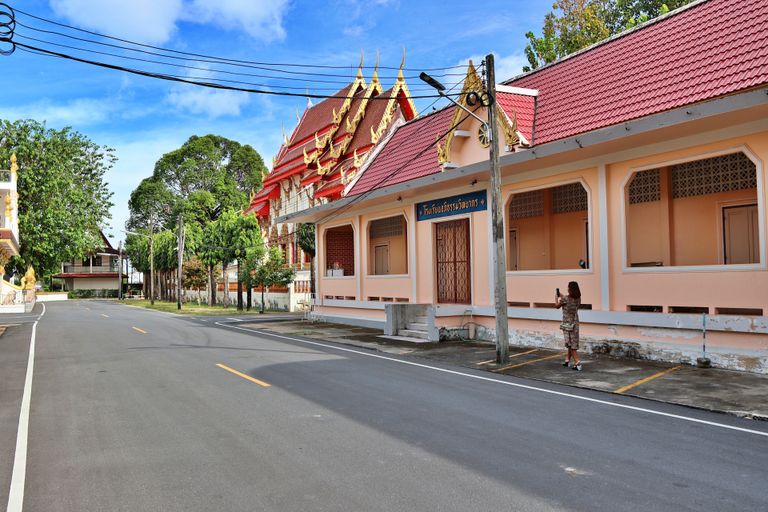
Beyond its role as a place of worship, Wat Nakaram is also a monastic school, where young novices and monks study the teachings of Buddhism. Here, they learn about the Buddha’s teachings (Dharma), meditation practices, and the monastic code of conduct. This educational aspect of the temple plays an important role in preserving and passing on Buddhist traditions to the next generation.
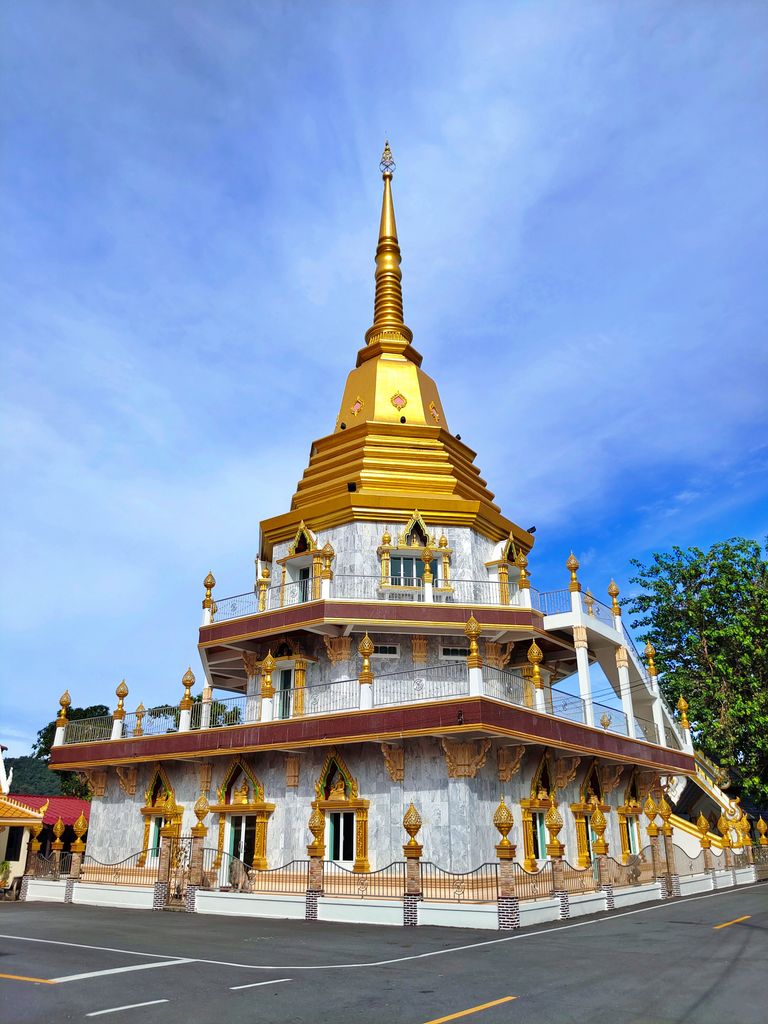
As you enter the temple grounds, your attention is immediately drawn to the towering 3-story golden pagoda, gleaming under the sunlight. This impressive structure stands as a symbol of enlightenment, reflecting the spiritual journey of the Buddha. The pagoda is an essential feature of Thai temples, traditionally designed to house sacred Buddha relics, such as hair, bones, or teeth, believed to carry the Buddha’s spiritual essence.
The layers of the pagoda often represent the three realms in Buddhism: the realm of desire, the realm of form, and the realm of formlessness. Visitors come to pay their respects and make offerings, believing that the act of worshipping at the pagoda brings good karma and blessings. The intricate golden detailing symbolizes purity, wisdom, and the path to enlightenment.
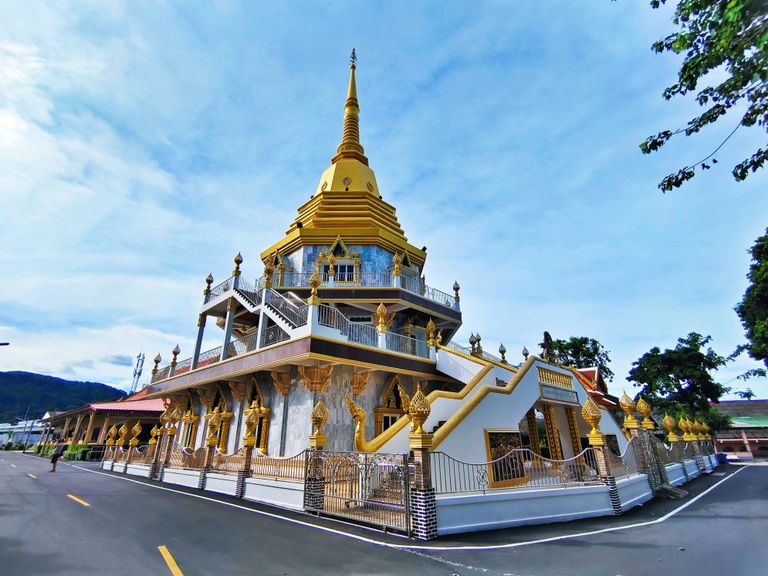
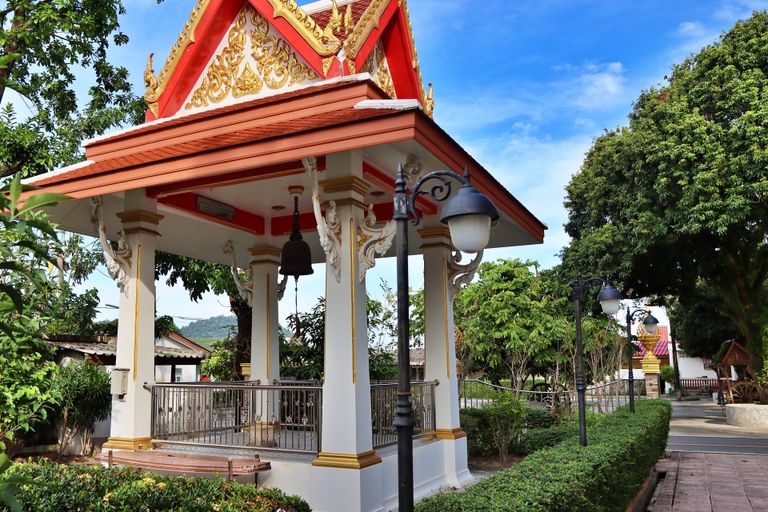
On the side of the pagoda, you’ll notice a large bronze bell, often seen at Thai temples. Traditionally, this bell is used for more than just telling the time—it’s an essential part of Buddhist rituals. Devotees strike the bell gently after making an offering or praying, as the sound is believed to carry their prayers and good intentions to the heavens.
The resonating sound of the bell symbolizes the impermanence of life, reminding us of the fleeting nature of our existence and encouraging mindfulness. In many temples, ringing the bell is also a way of showing respect and gratitude for the Buddha’s teachings, as well as invoking good karma and blessings.
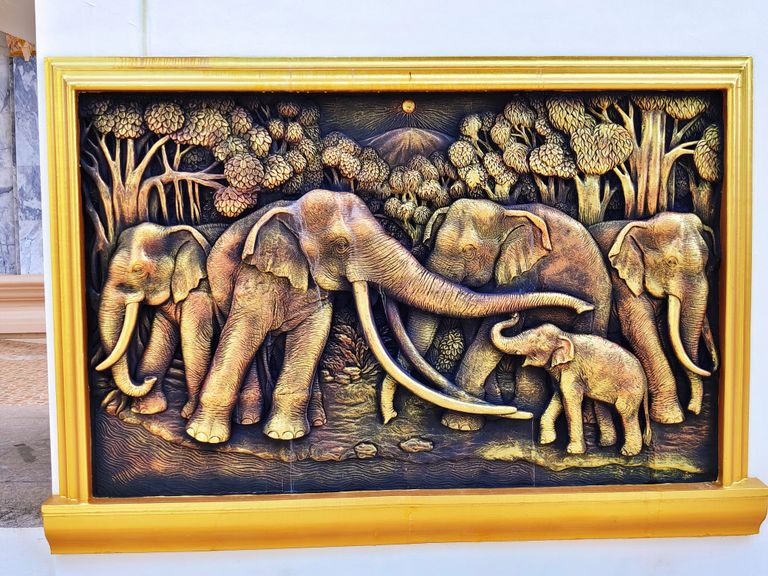
In Thai culture, elephants hold a special place of reverence and are considered a symbol of strength, wisdom, and good fortune. It’s common to see them represented in temples as paintings or statues, reflecting their importance in Thai history and spiritual beliefs. Here at Wat Nakaram, the outer wall of the pagoda features two elegant elephant sculptures, adding a majestic touch to the temple grounds.
Elephants are closely associated with Buddhism in Thailand, often linked to stories of the Buddha. One such tale is about a white elephant that is believed to have appeared to Queen Maya of Sakya before the birth of Prince Siddhartha (the Buddha), signifying the arrival of a great and enlightened being.
In many temples, elephant statues also serve as guardians, symbolizing the protection of the sacred space and the purity of the Buddha’s teachings. 🐘✨🙏
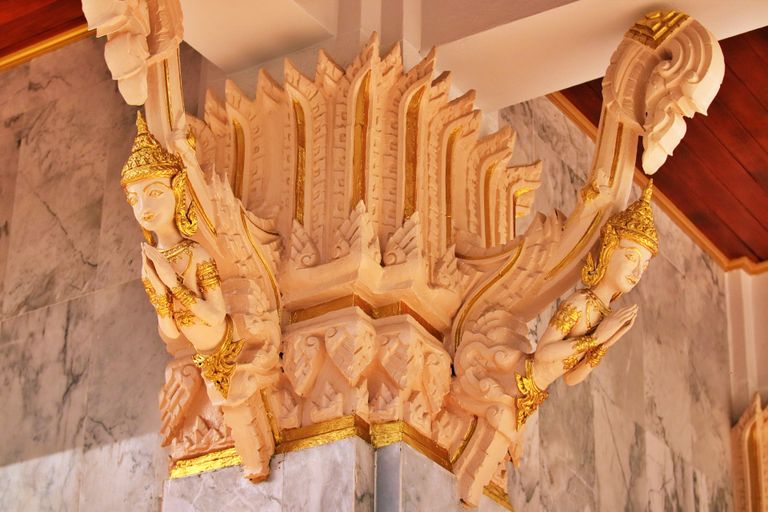
Each pillar of the pagoda at Wat Nakaram features statues of Thewada (เทวดา), or celestial beings, which are commonly known as Thai angels. These graceful figures are attached to the corners of the poles, depicted with hands in a wai (prayer gesture), symbolizing respect and devotion.
The Thewada are believed to be protectors of the temple, acting as divine guardians who watch over the sacred grounds. In Thai Buddhism, they are often associated with the spiritual realm and are said to inhabit the heavens, watching over humans and guiding them towards good deeds.
Their presence on the pagoda adds a spiritual layer, inviting blessings and symbolizing a connection between the earthly realm and the divine. ✨🙏👼
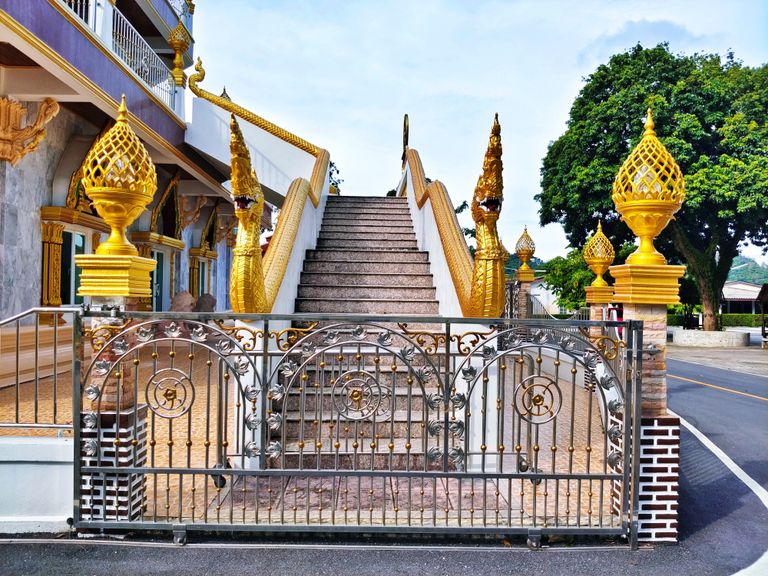
Sadly, the entrance to the pagoda was closed that day, leaving us a bit disappointed as we couldn’t explore its interior. However, while my husband was busy taking photos of the golden structure, a friendly monk approached us. He noticed that we were the only visitors around and, in a gesture of kindness, offered us an exception—inviting us to go upstairs and take a look inside. 🙏✨
It felt like a rare opportunity and a special moment of hospitality that made our visit even more memorable. 💛
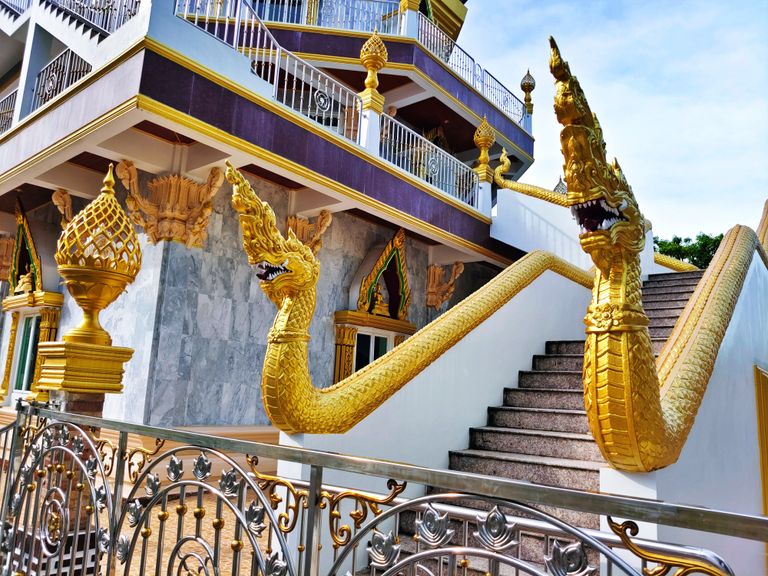
As we ascended the steps, we were greeted by two magnificent Nāgas guarding the staircase. These serpentine creatures, with their intricately detailed scales and fierce expressions, are believed to be protectors of sacred sites in Thai Buddhist tradition. In Thai culture, the Nāga is a symbol of strength, protection, and fertility, often seen as a guardian of temples, watching over the spiritual journey of visitors. 🐉🙏
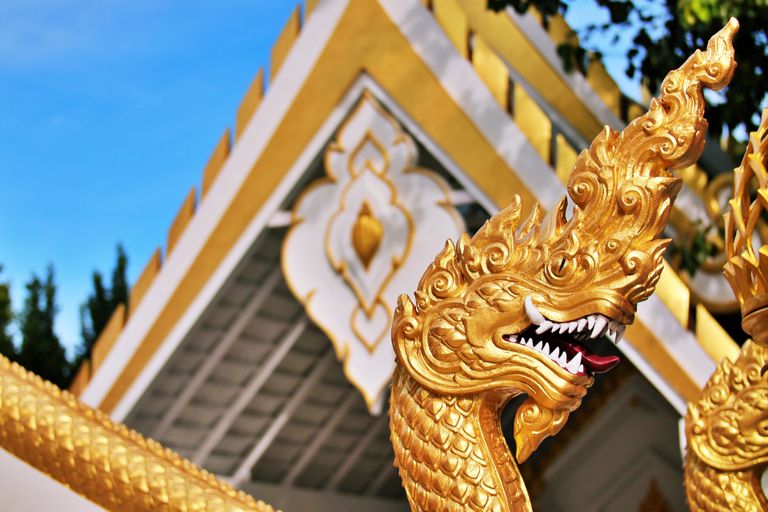
เดินเข้ามาภายในบริเวณวัด ก็จะเห็นเจดีย์สีทองขนาดใหญ่ ตั้งตระหง่านอยู่กลางวัด เจดีย์นี้เป็นที่เก็บพระบรมสารีริกธาตุ ของพระพุทธเจ้า ถัดจากเจดีย์ก็เป็นหอระฆัง ที่ใช้สำหรับตีบอกเวลา รอบๆ เจดีย์ก็จะมีรูปของโขลงช้าง ซึ่งบัวเห็นมันสวยดี รอบๆ เจดีย์ก็เหมือนกับหลายๆ ก็จะมีเทวดาประจำอยู่แต่ละเสาของเจดีย์ มีราวบันไดเป็นรูปพญานาค
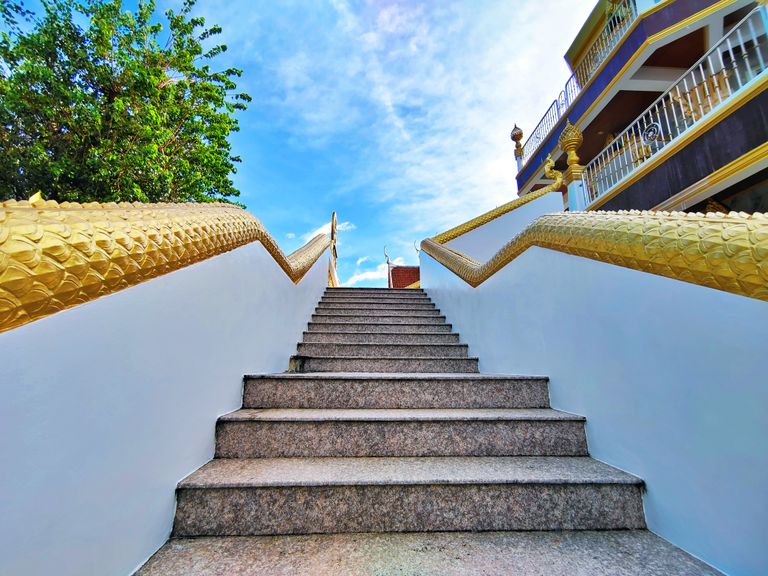
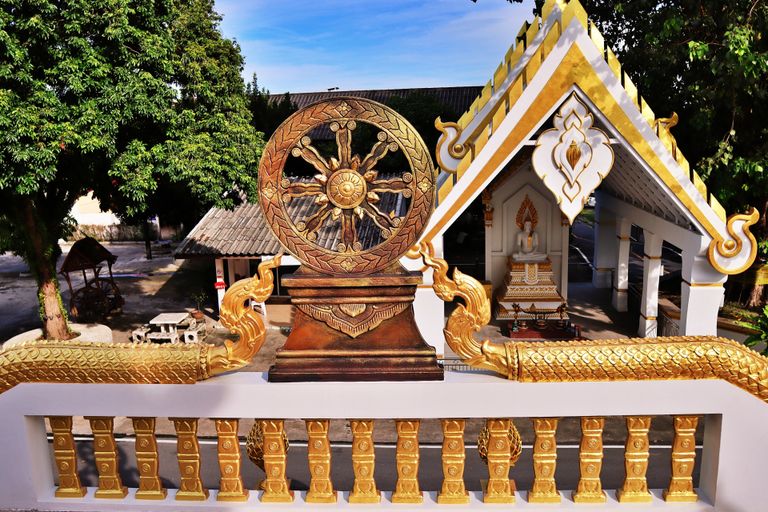
We climbed up to the second floor of the pagoda, where a peaceful balcony awaited us. At the center, nestled between the elegantly coiled tails of two Nāgas, stood the Dharma Chakra (Wheel of Dharma) 🌀. This symbol, one of the most important in Buddhism, represents the teachings of the Buddha and the path to enlightenment. It is a reminder of the noble truths and the cycle of life, guiding devotees on their spiritual journey.
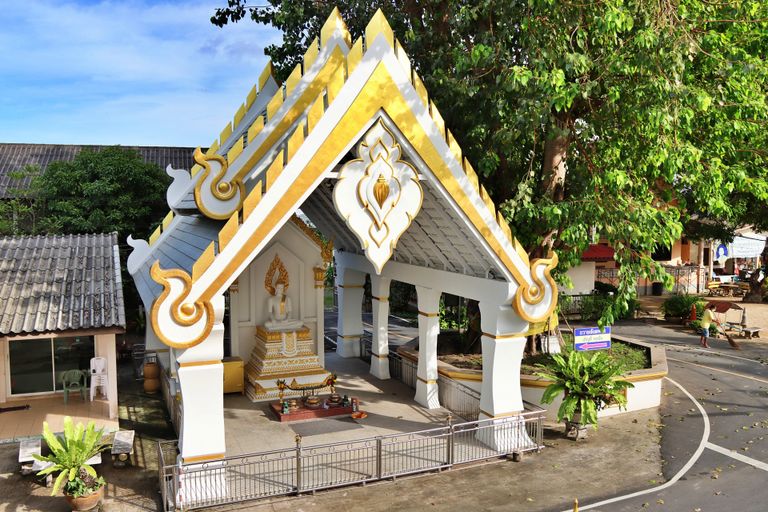
Looking down from the balcony, we spotted a small yet elegant pavilion nestled in the temple grounds. Inside, a serene Buddha statue is gracefully enshrined, surrounded by offerings of flowers and incense. The peaceful expression on the Buddha’s face seemed to radiate a sense of calm and tranquility, inviting visitors to pause and reflect, even from afar. The pavilion, though modest, adds a charming and sacred element to the temple's serene atmosphere. 🙏🌺
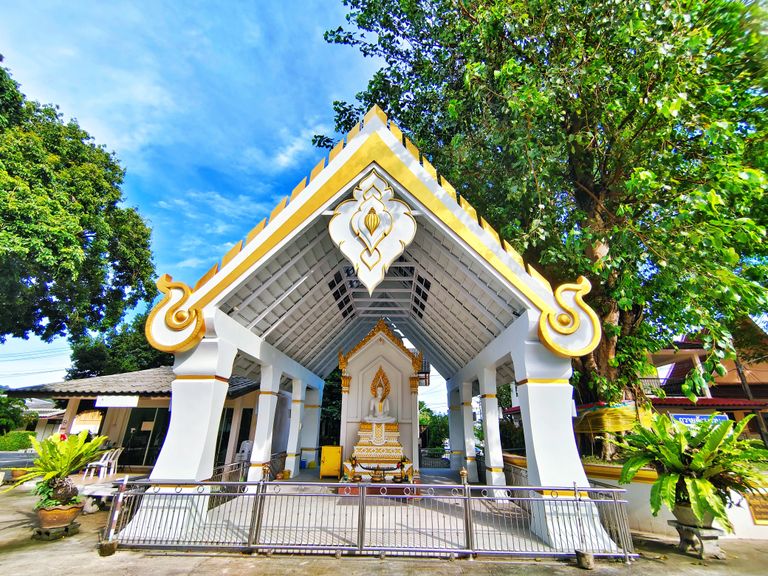
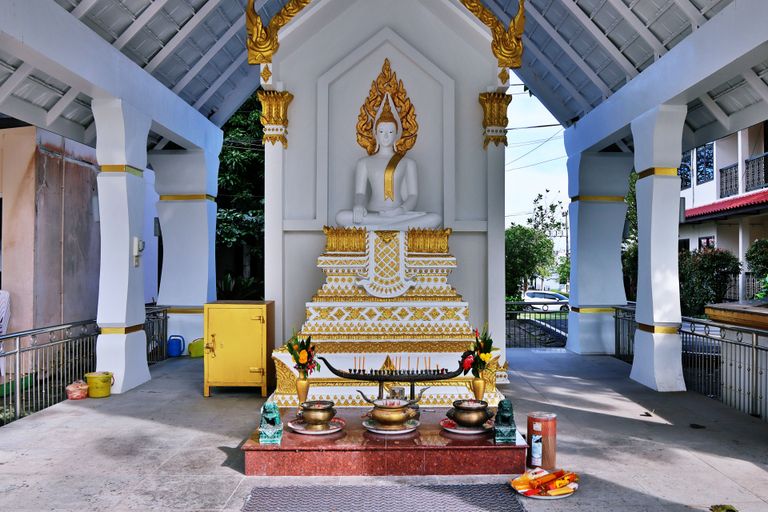
ตอนที่สานางกำลังถ่ายรูปอยู่นั้น ก็มีพระรูปหนึ่ง เดินมาบอกว่า "โยมขึ้นไปถ่ายรูปด้านบนเจดีย์ได้นะ ก่อนขึ้นให้ถอดรองเท้าด้วย" บัวก็กล่าวขอบคุณในน้ำใจของพระรูปนั้น เพราะตั้งแต่มีโควิดระบาดวัดต่างๆ จะปิดไม่ให้เข้าไปด้านในเลย
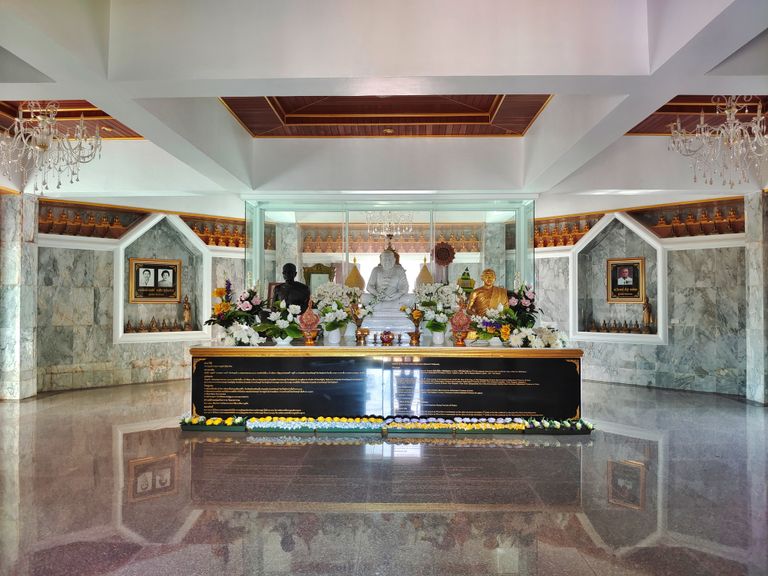

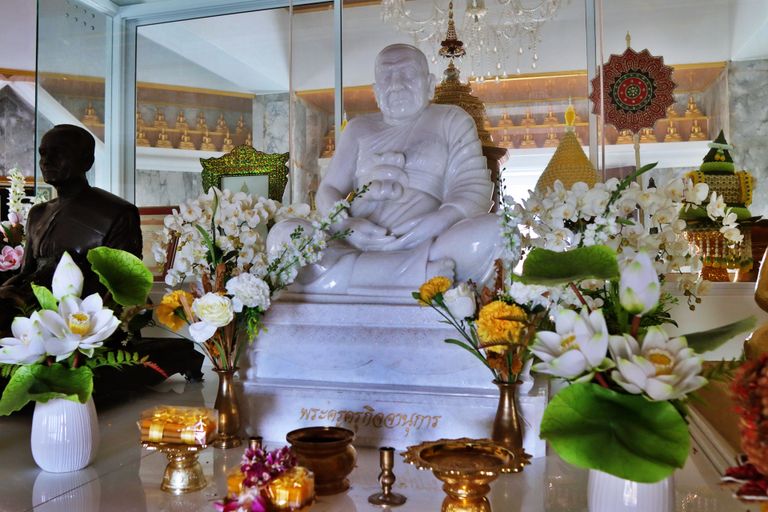
On the second floor, we stepped inside a quiet chamber filled with an air of reverence. At the center stood a lifelike statue of the founding abbot, crafted with meticulous detail to honor his legacy. The abbot, who played a pivotal role in establishing Wat Nakaram, is depicted in a seated meditation posture, symbolizing wisdom and serenity. Devotees often leave offerings of flowers, incense, and candles at the statue's base, as a mark of respect and gratitude for his contributions to the temple’s history and spiritual community. 🙏🌿
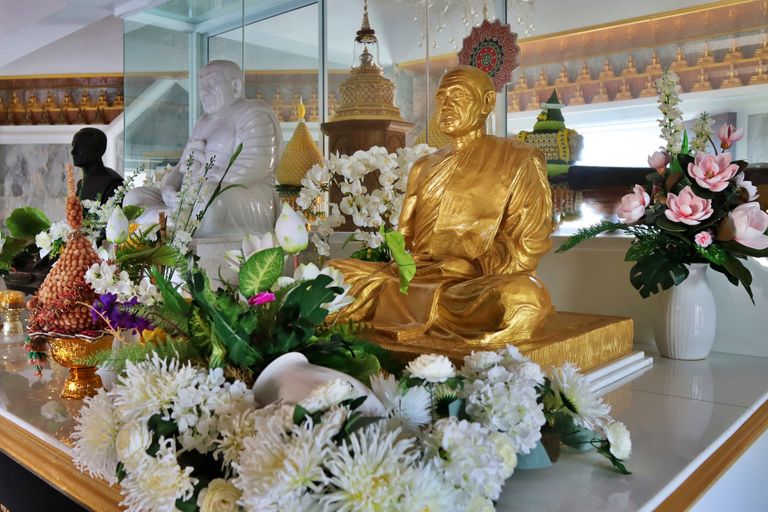
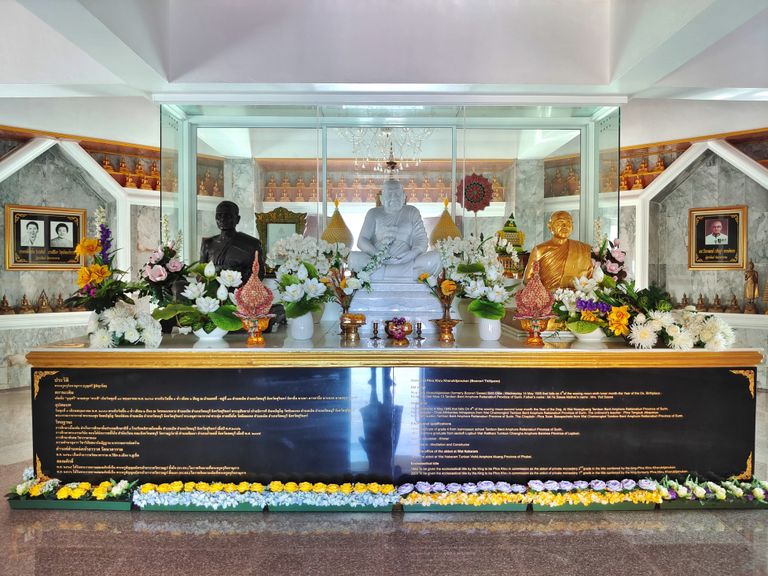
On a plaque beneath the statue, the life and achievements of the founding abbot, Phra Khru Kharukitjanukan (Boonsri Thitiyano), are detailed, highlighting his remarkable journey and contributions to the temple.
Biography of Phra Khru Kharukitjanukan (Boonsri Thitiyano)
Early Life
Born as Boonsri Saess on Wednesday, May 14, 1925 (Year of the Ox), in Tambon Berd, Amphore Rattanabun, Surin Province. He was the son of Mr. Ya Sasee and Mrs. Yod Sase.
Ordination
He was ordained as a monk on Wednesday, May 4, 1946 (Year of the Dog), at Wat Noangluang in Surin Province. His preceptor was Chao Athikantee Inthapanyo from Wat Chaimongkol, with Phra Tongsuk Jittapanyo and Phra Toom Sasapachoto guiding him through his spiritual training.
Education
- 1939: Completed Grade 4 from Isannoason School, Surin Province.
- 1952: Graduated in Dhamma studies from Lopburi at Wat Ratthani.
- Specialized in Khmer language, with expertise in meditation and temple construction.
Abbot at Wat Nakaram
In 1977, he became the abbot of Wat Nakaram, located in Wichit Subdistrict, Phuket. Under his leadership, the temple flourished and became an important spiritual center.
Ecclesiastical Titles
- 1982: Awarded the title of Phra Khru, 2nd grade abbot, by the King.
- 2003: Promoted to Phra Khru, 1st grade abbot, in recognition of his outstanding service and dedication.
In Thai temples, the Buddha relics (known as พระบรมสารีริกธาตุ, Phra Borom Sareerikatat) typically include fragments of bones, ashes, or even teeth believed to be remains of the historical Buddha, Siddhartha Gautama. These relics are considered immensely sacred and are often enshrined in the uppermost level of a chedi (pagoda), as they are meant to symbolize the Buddha's spiritual presence and serve as objects of veneration.
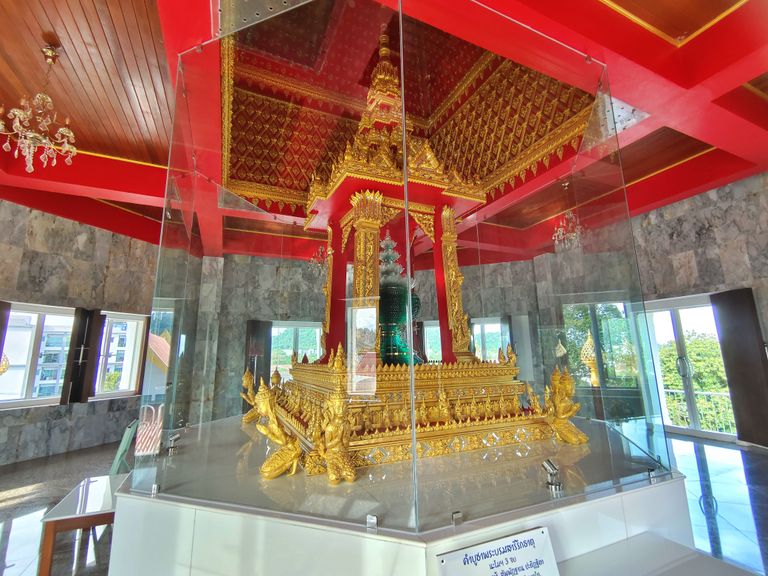
On the third floor of the pagoda, you will find the revered relics of the Buddha, kept securely in a large glass display. The relics, surrounded by an intricate glass case, are believed to contain fragments of the Buddha’s bones. It’s a serene and sacred space where visitors can offer their respects and feel a connection to the Buddha’s teachings.
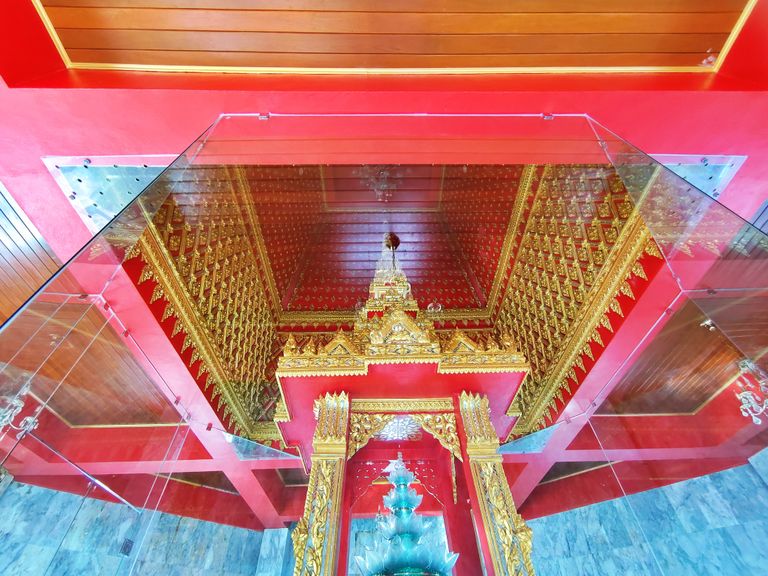
เจดีย์นี้มีอยู่ 3 ชั้น แต่ชั้นแรกบัวไม่ได้เข้าไปด้านใน บัวเดินขึ้นไปชั้นที่ 2 และ 3 เลย ชั้นที่ 2 เป็นประวัติของเจ้าอาวาสที่อยู่ตั้งแต่แรกเริ่มเดิมที ชั้น 3 ก็จะเป็นที่เก็บพระบรมสารีริกธาตุ ซึ่งเก็บไว้ในโหลแก้วขนาดใหญ่ แถมด้านนอกยังมีกระจกกั้นอีกชั้น การถ่ายรูปที่เป็นกระจกแบบนี้บัวไม่ชอบเลย มันสะท้อน ทำให้ภาพออกมาไม่สวย
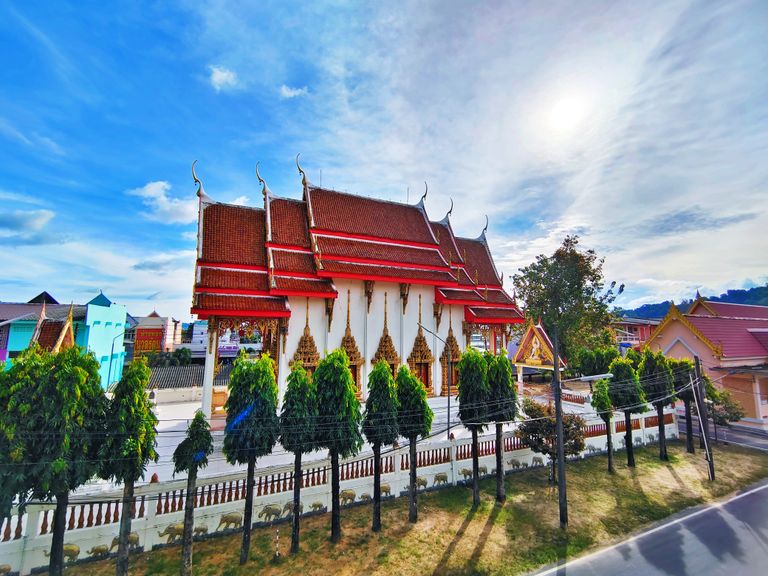
Looking down from the third floor, you can see the beautiful ubosot (ordination hall) below. This chapel is one of the most important buildings in the temple complex, serving as the sacred space where monks gather to chant the Patimokkha (monastic rules) and perform ordinations. The architecture features high, steeply sloping roofs, reminiscent of traditional Thai houses, with intricate details that reflect the elegance of Thai craftsmanship. This hall is not just a place of worship but a symbol of spiritual purity and dedication.
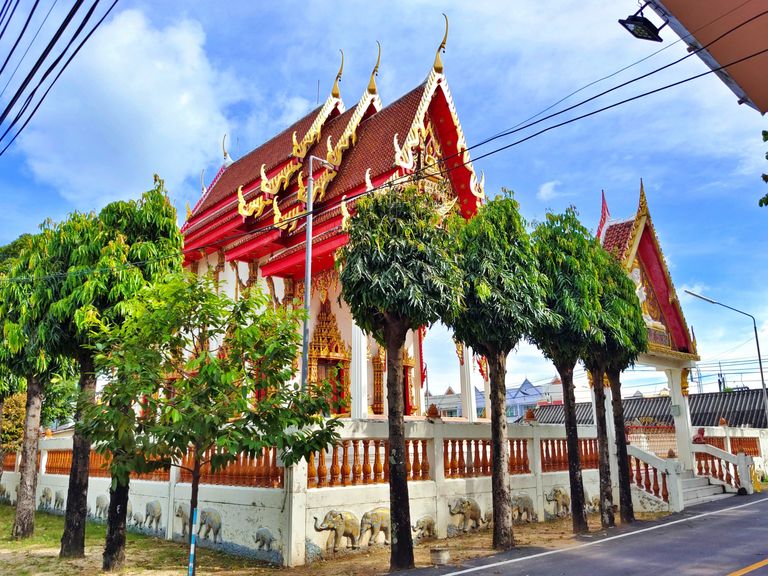
หลังจากที่ลงมาจากเจดีย์แล้ว บัวก็มาถ่ายรูปอุโบสถด้านล่าง เป็นอุโบสถที่มีความสวยงามมากๆ กำแพงที่ล้อมรอบอุโบสถก็จะเป็นรูปช้างตัวเล็ก และตัวใหญ่กำลังเดิน ช่วงโควิดนี้วัดทุกวันส่วนใหญ่แล้วจะเงียบ ไม่มีค่อยมีผู้คนเข้ามาทำบุญที่วัดเท่าไหร่ ไม่เหมือนกับวัดดังๆ ที่แม้แต่โควิดก็ยังเอาไม่อยู่ ต้องไปสักครั้ง
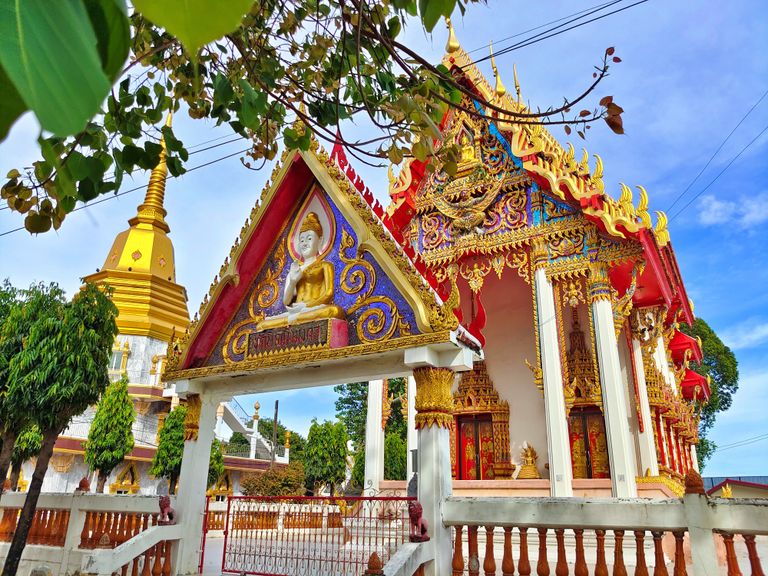
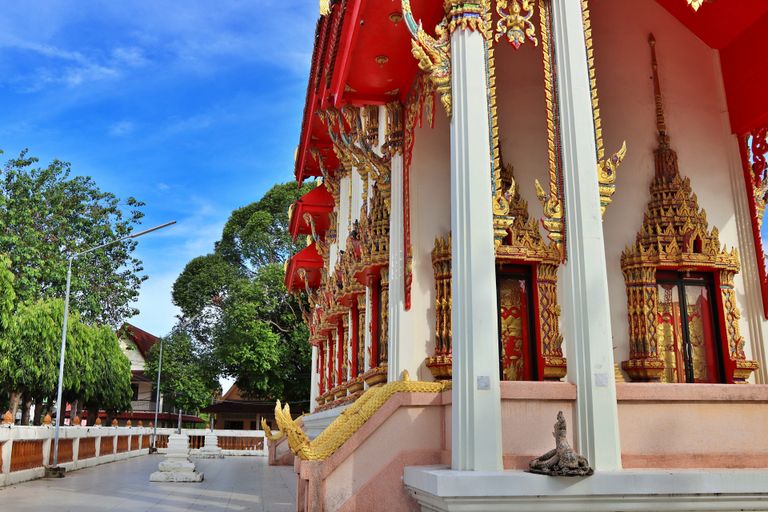
วันที่บัวถ่ายรูป บัวชอบรูปนี้ ตอนที่ถ่ายรูปบัวยืนอยู่ใต้ต้นโพธิ์ใหญ่หน้าอุโบสถ ทำให้เห็นตัวของโบสถ์ เจดีย์ มีท้องฟ้าสีฟ้าเป็นพื้นหลัง
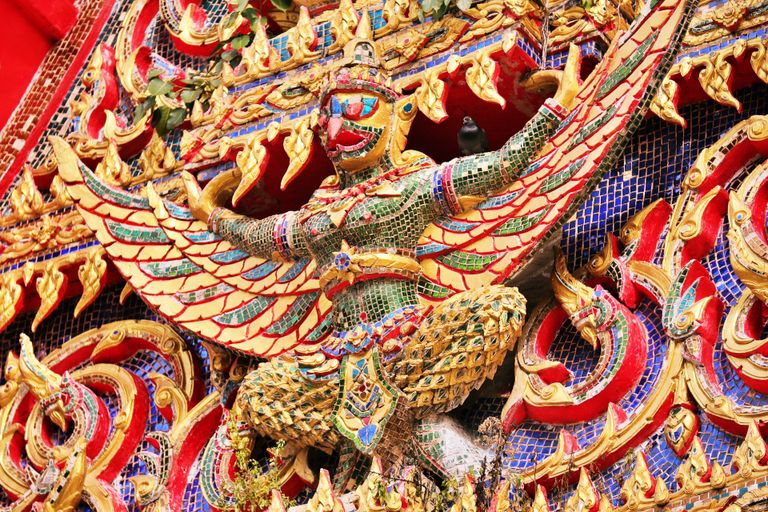
This is a statue of Garuda (ครุฑ), a revered figure in Thai mythology and an emblem of great significance. According to ancient Thai beliefs, Garuda is the king of all birds and the divine vehicle (vahana) of Lord Vishnu, one of the principal deities in Hinduism. He is depicted as a powerful being, half-man and half-eagle, symbolizing strength, courage, and divine protection. In Thai culture, Garuda is considered a symbol of royal power and is often seen as a national emblem. He is believed to be blessed with immortality and invulnerability, making him a guardian figure against evil forces.
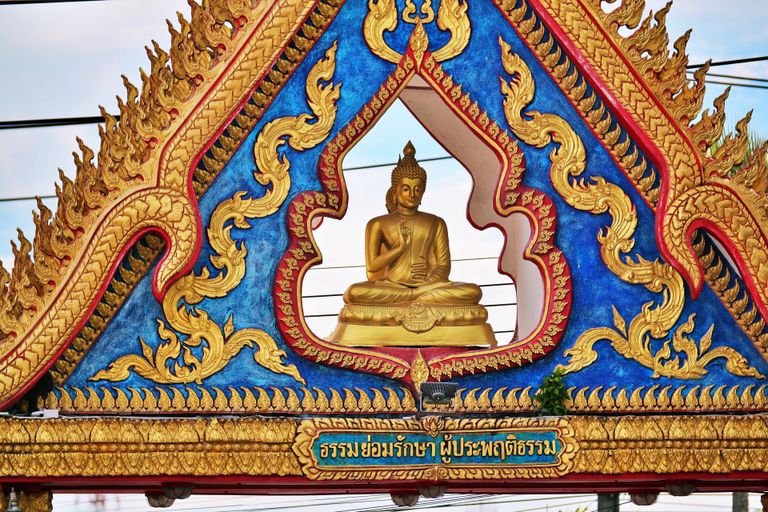
Religion and beliefs are the pillars of every culture, shaping the values, traditions, and emotions of its people. I hope our stroll through Wat Nakaram has given you a glimpse into the heart of Thai culture and its profound spirituality. It’s a place where history, faith, and local life beautifully intertwine.
As a little treat, I’ve included a video of the vibrant Phuket Naka Weekend Market, located just across from the temple. Make sure to check it out—it’s a lively spot full of flavors, sounds, and unique finds!

Thank you for joining me on this cultural journey. If you enjoyed this post, please don’t forget to reBlurt, follow, and leave a comment to share your thoughts. Your support means the world to me, and I can’t wait to bring you along on my next adventure. 💖✨
| 📷 Photo Credit | Smartphone |
|---|---|
| Model | Vivo X60 5G |
| Type | Android |
| Photographer | @baiboua |
| Location | Wat Nakaram, Wichit Subdistrict, Phuket, Thailand |
🌸 Thank you for your support 🌸
💖 ขอบคุณสำหรับการโหวต 💖
💕 เลิฟนะยู้ววววววว 💕
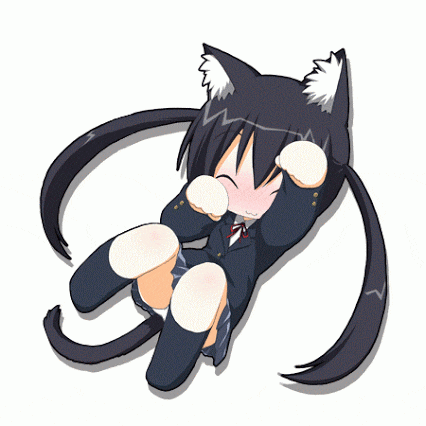
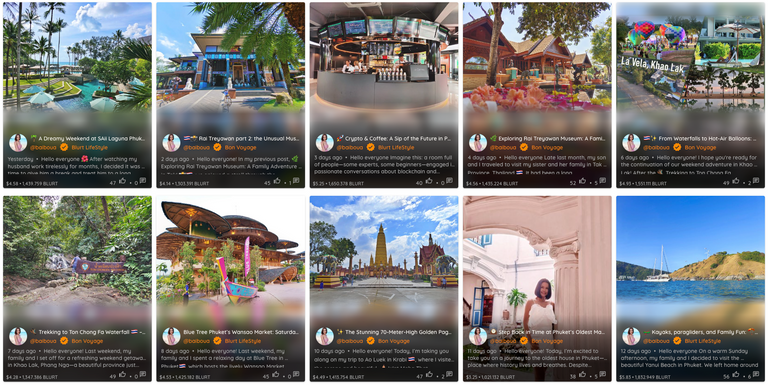
I have seen lot of Buddhist temples but this one is the best.Thanks for sharing with us.
Thanks, I have a few more incredible temple visits to publish that should surprise you 🌼